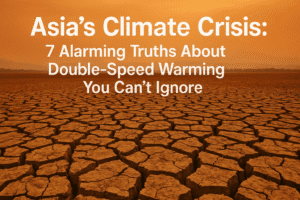Asia’s Climate Crisis: 7 Alarming Truths About Double-Speed Warming You Can’t Ignore
Asia faces a climate emergency, warming at twice the global average rate according to the WMO’s 2024 report. This accelerated heating fueled devastating extremes: relentless heatwaves killed hundreds across India, Japan, and beyond, while record-shattering rainfall triggered deadly floods and landslides in Kerala and Nepal. Crucially, warming oceans – heating nearly twice as fast globally – expanded severe marine heatwaves and intensified cyclones like Remal and the rare Arabian Sea storm Asna, causing widespread destruction.
Simultaneously, 23 of 24 monitored Himalayan and Tian Shan glaciers lost mass, escalating immediate threats like catastrophic glacial floods while undermining long-term water security for billions. Rising seas, outpacing global rates around Asia, further endanger coastal regions. This convergence of record heat, vanishing ice, fiercer storms, and rising oceans exacts a severe human and economic toll, underscoring an existential threat demanding unprecedented global and regional action.

Asia’s Climate Crisis: 7 Alarming Truths About Double-Speed Warming You Can’t Ignore
The World Meteorological Organization’s (WMO) 2024 State of the Climate in Asia report delivers a stark, scientifically undeniable verdict: Asia is heating up at roughly twice the global average rate. This isn’t just a worrying statistic; it’s the engine driving a terrifying surge in extreme weather, exacting a devastating human, economic, and ecological toll across the continent.
Beyond Record Heat: A Continent Under Siege
While 2024 officially being Asia’s warmest year on record grabs attention, the WMO findings reveal a far more complex and dangerous cascade of impacts:
- The Human Cost is Already Here:
- Deadly Heat: India witnessed over 450 fatalities due to intense heatwaves, a grim reality repeated across the region. Record-shattering temperatures plagued East Asia for months, with Japan, Korea, and China breaking monthly records repeatedly. Thailand, Myanmar, Saudi Arabia, and even Russia’s northwest faced blistering, unprecedented heat.
- Water’s Wrath: Extreme rainfall became a brutal killer. Landslides triggered by 500mm of rain in 48 hours killed over 350 in Kerala, India. Nepal saw 246 deaths and massive economic damage from catastrophic floods. The UAE experienced one of its most extreme rainfall events ever recorded.
- The Ocean’s Fury: Cyclones like Remal (Bay of Bengal) and the rare Asna (Arabian Sea) caused widespread destruction and displacement in Bangladesh, India, Sri Lanka, and Oman. Flash floods and mudslides from a Glacial Lake Outburst Flood (GLOF) in Nepal displaced hundreds.
- The Accelerating Environmental Breakdown:
- Oceans in Overdrive: Asia’s seas are warming nearly twice as fast as the global average. 2024 saw the largest expanse of severe marine heatwaves ever recorded around Asia, stressing marine ecosystems vital for food and livelihoods.
- Vanishing Ice, Rising Threats: 23 out of 24 monitored glaciers in the Himalayas and Tian Shan lost mass. This isn’t just about scenic loss; it directly increases the risks of catastrophic GLOFs and landslides now, and threatens the long-term water security for billions downstream as natural reservoirs disappear.
- Creeping Crisis: Sea level rise around Asia, particularly in the Pacific and Indian Ocean regions, is outpacing the global average, silently encroaching on densely populated coastal communities and economies.
- The Deepening Economic and Social Scarring:
- Drought in China impacted millions, ruined crops, and caused billions in losses.
- Lightning strikes claimed an astonishing 1,300 lives across India.
- The cumulative damage from floods, storms, droughts, and heatwaves isn’t just measured in immediate costs; it erodes infrastructure, disrupts supply chains, destroys crops, displaces communities, and sets back development goals by years or decades.
Why This Report Demands More Than Passive Reading
The WMO report is not merely a catalog of disasters; it’s a flashing red siren:
- Climate Injustice Amplified: Asia, home to a vast portion of the world’s population and contributing significantly less historically to emissions per capita, is bearing a disproportionate brunt. The “twice the global average” warming is a profound injustice.
- The Domino Effect is Real: The report meticulously connects the dots. Faster warming fuels hotter oceans, which energize stronger cyclones and increase rainfall intensity. It accelerates glacier melt, increasing immediate hazards while undermining future water stability. Heatwaves cripple productivity and health.
- Adaptation is Failing to Keep Pace: The sheer scale and increasing frequency of these events suggest current adaptation measures, while crucial, are insufficient against this accelerating onslaught. The events in Kerala, Nepal, and the Himalayan GLOF are tragic examples.
- A Regional (and Global) Emergency: No single nation can wall itself off from these interconnected crises. Transboundary rivers fed by vanishing glaciers, cyclones crossing national boundaries, and shared ocean resources mean regional cooperation on mitigation, adaptation, early warning, and disaster response is not optional – it’s existential.
The Unavoidable Conclusion: Action, Not Just Awareness
The 2024 State of the Climate in Asia report removes any remaining doubt. Asia is on the front lines of a climate crisis intensifying at a terrifying speed. The “twice the global average” warming is translating directly into lives lost, homes destroyed, economies shattered, and ecosystems pushed to the brink.
The genuine human insight here is the realization that these aren’t isolated disasters, but symptoms of a continent-wide system in accelerating distress. The value for readers lies in understanding the profound interconnectedness of these impacts and the absolute urgency for:
- Radically accelerated global emissions reductions (the primary driver).
- Massively scaled-up, coordinated regional adaptation and resilience-building, especially for the most vulnerable communities.
- Unprecedented investment in early warning systems and disaster preparedness.
- Prioritizing the protection and restoration of critical natural defenses like mangroves, forests, and wetlands.
The data is clear, the science is unequivocal, and the suffering is evident. Asia’s double-speed warming is a crisis unfolding in real-time, demanding a response commensurate with the scale of the threat. The time for incremental steps is over; the WMO report is a call for transformative action before the toll becomes unimaginable. The continent’s future stability, prosperity, and very habitability depend on it.
You must be logged in to post a comment.